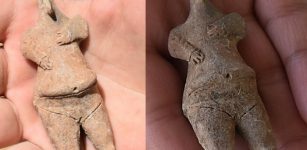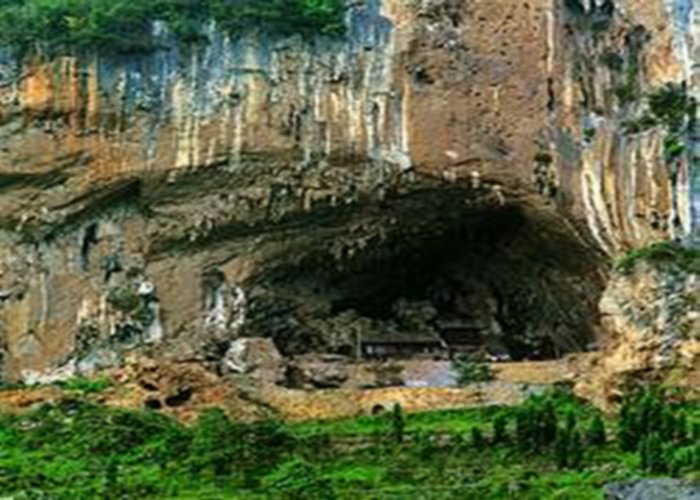Mystery Of Panxian Cave: How Could Gigantic Animals Reach A Mountain Cave Located Over 1600m Above Sea Level?
A. Sutherland - AncientPages.com - Did early Homo sapiens exist in China at the same time when Homo erectus (the "Peking Man") occupied the Zhoukoudian site located near Beijing?
The Panxian Dadong is a Paleolithic karst cavern located in a small valley 1630 m above sea level on the western Guizhou Plateau, Southern China.
Humans were present at Panxian Dadong Cave about 300,000 years ago and so were also gigantic animals. But scientists are baffled over how these animals could reach a mountain cave located over 1600m above sea level!
In Panxian cave lived one of Asia's earliest human populations. Large deposits up to 19 meters deep contribute with satisfactory evidence of that.
Prehistoric deposits analyzed in the Panxian Dadong Cave indicate that such animals as elephant-like Stegodons and lumbering Rhinoceros lived there.
There has been found a large number of remains which belong to these large animals. The Panxian Dadong, (the name "Dadong" means "grand"), revealed a complete deposit of the Middle Pleistocene period. Diggings uncovered over 40 species of mammals, stone artifacts, human teeth, and animal teeth. Over 30 percent of the large animal remains constitute teeth and approximately 2 percent of remains are related to their skulls.
Mostly all those teeth come from very large animals like buffalos, Rhinoceros, and Stegodons.
The cave is the central cavern of three stacked caves extending into a hillside. The central cave, 220 meters deep, covers 8000 square meters.
Test excavations showed that humans used the cave over a long period of time. The uranium-lead dating technique gave indications that the deposits are at least 300,000 years old, and they may go back as far as 700,000 years ago.
The Panxian Dadong Cave system, where digging unearthed a fossilized human tooth, may hold some important answers in this matter.
Some years ago, an expedition to Guangxi province (neighboring province to that of Guizhou), in Southeast Asia established that Gigantopithecus blackii, a large ape, 10 feet tall (3 meters) and weighing about 1,200 pounds (544 kg), lived at the same time as early humans for over a million years.
It was the largest primate that ever lived. Gigantopithecus blackii died out 100,000 years ago during the Pleistocene period. Considering the time range from 1,000,000 to 100,000 years, it would mean that Gigantopithecus blackii coexisted with Homo erectus in this region of Asia. It is believed that the gigantic primate also roamed certain areas of Thailand.
Archaeological material found in Guangxi caves in the form of fossils of humans and Gigantopithecus blackii supports the theory.
The Panxian Dadong is only one of many caves of China and Tibet. Thousands of others, very old and with a great variety of shapes hosted rather prehistoric people than animals.
Both China and Tibet have numerous secret caves. Many of them, created by people rather than natural processes, have symbolic and sacred meaning.
Written by – A. Sutherland AncientPages.com Staff Writer
Copyright © AncientPages.com All rights reserved. This material may not be published, broadcast, rewritten or redistributed in whole or part without the express written permission of AncientPages.com
More From Ancient Pages
-
 Ancient Iconic Armenian Wheel Of Eternity Depicted Inside A Six Pointed Star
Ancient Symbols | Feb 27, 2017
Ancient Iconic Armenian Wheel Of Eternity Depicted Inside A Six Pointed Star
Ancient Symbols | Feb 27, 2017 -
 7,800-Year-Old Clay Female Figurine Unearthed In Ulucak Mound, Turkey’s Izmir
Archaeology | Aug 17, 2022
7,800-Year-Old Clay Female Figurine Unearthed In Ulucak Mound, Turkey’s Izmir
Archaeology | Aug 17, 2022 -
 Newly Described Species Of Dome-Headed Dinosaur May Have Sported Bristly Headgear
News | May 24, 2023
Newly Described Species Of Dome-Headed Dinosaur May Have Sported Bristly Headgear
News | May 24, 2023 -
 Pregnant Woman’s Remains With An 8-Month Fetus Unearthed At Ancient Taosibei Cemetery, Shanxi, China
Archaeology | Jun 13, 2022
Pregnant Woman’s Remains With An 8-Month Fetus Unearthed At Ancient Taosibei Cemetery, Shanxi, China
Archaeology | Jun 13, 2022 -
 What Does The Brain Of The Homo Erectus Fossil With The Lowest Cranial Capacity Tell About Evolution?
Archaeology | Mar 2, 2023
What Does The Brain Of The Homo Erectus Fossil With The Lowest Cranial Capacity Tell About Evolution?
Archaeology | Mar 2, 2023 -
 Skidi Pawnee Indians: One Of The Most Proficient Astronomers Of Ancient Times And Their Sophisticated Star Chart
Featured Stories | Nov 28, 2024
Skidi Pawnee Indians: One Of The Most Proficient Astronomers Of Ancient Times And Their Sophisticated Star Chart
Featured Stories | Nov 28, 2024 -
 On This Day In History: First Siege Of Rome Began – On March 2, 537
News | Mar 2, 2017
On This Day In History: First Siege Of Rome Began – On March 2, 537
News | Mar 2, 2017 -
 Mystery How Humans Lost Their Body Hair Solved By Scientists
Archaeology | Jan 4, 2023
Mystery How Humans Lost Their Body Hair Solved By Scientists
Archaeology | Jan 4, 2023 -
 Aillén Mac Midgna: Evil Goblin Who Terrorized Sacred Hill Of Tara
Celtic Mythology | Mar 28, 2024
Aillén Mac Midgna: Evil Goblin Who Terrorized Sacred Hill Of Tara
Celtic Mythology | Mar 28, 2024 -
 Who Were Or Are The Ninja – Those Ancient Spies And Mercenaries?
Featured Stories | Jul 3, 2018
Who Were Or Are The Ninja – Those Ancient Spies And Mercenaries?
Featured Stories | Jul 3, 2018 -
 Ancient Tools Found In Maryland Re-Write The History Of First Humans In America
Archaeology | May 29, 2024
Ancient Tools Found In Maryland Re-Write The History Of First Humans In America
Archaeology | May 29, 2024 -
 Lost Ancient Pyramid City As Big As Manhattan Discovered In Mexico
Archaeology | Feb 17, 2018
Lost Ancient Pyramid City As Big As Manhattan Discovered In Mexico
Archaeology | Feb 17, 2018 -
 House Of Plantagenet – How Hatred, Revenge And Jealousy Transformed History
Featured Stories | Jul 27, 2018
House Of Plantagenet – How Hatred, Revenge And Jealousy Transformed History
Featured Stories | Jul 27, 2018 -
 Modern Humans Traveled Across The Eurasian Steppe 45,000 Years Ago
Archaeology | Aug 20, 2019
Modern Humans Traveled Across The Eurasian Steppe 45,000 Years Ago
Archaeology | Aug 20, 2019 -
 Heliopolis ‘Sun City’ Was One Of The Most Ancient Cities Of Egypt
Featured Stories | Oct 6, 2021
Heliopolis ‘Sun City’ Was One Of The Most Ancient Cities Of Egypt
Featured Stories | Oct 6, 2021 -
 Mama Cocha – Inca Goddess Of The Sea With Strong Connection To Lake Titicaca, Peru
Featured Stories | May 26, 2020
Mama Cocha – Inca Goddess Of The Sea With Strong Connection To Lake Titicaca, Peru
Featured Stories | May 26, 2020 -
 3D Scan Will Uncover Secrets Of The Magnificent Vindelev Gold Treasure
Archaeology | Oct 25, 2023
3D Scan Will Uncover Secrets Of The Magnificent Vindelev Gold Treasure
Archaeology | Oct 25, 2023 -
 New Models Shed Light On Life’s Origin
DNA | Feb 13, 2023
New Models Shed Light On Life’s Origin
DNA | Feb 13, 2023 -
 Mystery Of The First Dinosaurs Deepens – Is The Supercontinent Gondwana The Answer?
Paleontology | Jan 24, 2025
Mystery Of The First Dinosaurs Deepens – Is The Supercontinent Gondwana The Answer?
Paleontology | Jan 24, 2025 -
 On This Day In History: Dryburgh Abbey One Of Most Beautiful Of All Border Abbeys Of Scotland Founded – On Nov 10, 1150
News | Nov 10, 2016
On This Day In History: Dryburgh Abbey One Of Most Beautiful Of All Border Abbeys Of Scotland Founded – On Nov 10, 1150
News | Nov 10, 2016



